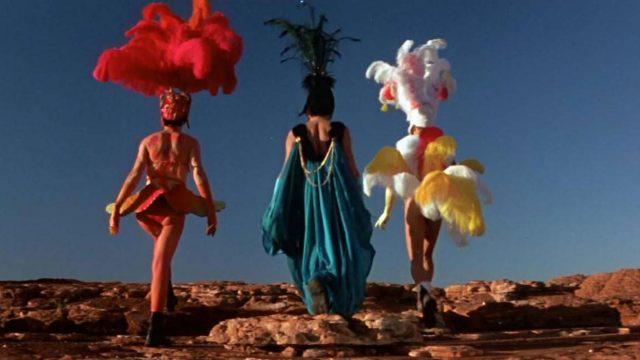I saw The Adventures of Priscilla, Queen of the Desert for the first time when I was thirteen, in 1994, in Brazil. I had never seen a queer movie in the cinema before – partly because there wasn’t much choice, partly because I had just recently started going to the movies on my own. No way I was gonna ask my father to take me to this film!
I was terrified. Afraid of abusers, pedophiles, and whatever else could happen (in my imagination) to a shy, painfully thin gay teenager in a huge movie theatre (it was at the biggest movie theatre in town, where I had seen blockbusters like Jurassic Park), watching a gay movie! Alone!
Nothing bad happened to me. The cinema was pretty much empty, even on a Saturday afternoon. But it was an unforgettable experience anyway: for the first time, I had the chance of seeing on the big screen a movie about gay characters who enjoyed their lives, embraced their queerness, while being charming and funny as hell. In these 25 years since watching it for the first time, The Adventures of Priscilla, Queen of the Desert has always followed me as a piece of work fundamental for my journey into self-acceptance. It didn’t happen overnight, but it surely made me feel better, relieved, happier.
The Adventures of Priscilla, Queen of the Desert has already achieved canon status (at least queer canon status) – and it’s wonderful to see how, for a change, the main actors weren’t pigeonholed after the success of the film. Terence Stamp already had a fantastic career, and Hugo Weaving and Guy Pearce went on to have memorable roles in some of the most striking movies of the next years. The Adventures of Priscilla, Queen of the Desert is in itself a movie difficult to pigeonhole, even more so in 1994: it’s unabashedly flamboyant, there’s no tragic ending, there are plenty of cheerful musical numbers, but every now and then there are harsh reminders that this is still a white, straight, male world. No wonder the trio ends up finding their most rapturous audience not among white people, but after a chance encounter with an Aboriginal tribe.
Watching the movie again prior to this column, I was a bit nervous regarding the problematic aspects of it – most notably the treatment of Cynthia (Julia Cortez), the Asian sex worker-cum-wife of Bob (Bill Hunter). As a teenager I found Cynthia hilarious, but I am completely aware that everything in her portrayal – her accent, her submissive tone at first, her fits of rage – screams “stereotype!” Well, it definitely is the most dated aspect of the film and one I will not try to defend. At the same time, it surprised me how her arc ultimately gives her agency: she frees herself from her not-necessarily-supportive husband and ends up doing what the hell she wants. And it is certainly memorable (no wonder the scene keeps being parodied in RuPaul’s Drag Race!)
It could be said that Cynthia is very much part of the Australian-ness of the movie, with its bonkers humor and weird touches (the lady running by herself that pops up every now and then). And thank heavens for all the freshness of Australian comedies! I doubt an American film would include a childhood flashback from Adam/Felicia (Pearce), when he tells how “Uncle Barry” tried to sexually abuse him. It’s a scene that goes from heavy to hilarious in seconds, and it’s a wonder.
After watching the film for the first time, I went and bought the soundtrack on CD. But some months later, stupid teenager me ended up selling it because that was not my kind of music (I was listening to a lot of Portishead and PJ Harvey at the time). But deep down I knew I wanted to get rid of the album because in my mind, every time a school friend came over to my house and noticed the CD, there would be a big sign saying “gay.” Self-hatred is no joke, and I know how much of myself I tried to hide or suppress during the years. In a pretty small step with a big significance to me, I saw myself this week seriously considering buying the album again. It rocks.


